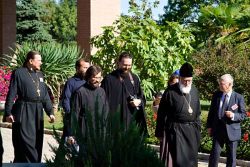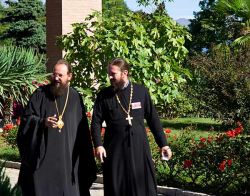Final press release
An opportunity for a fraternal exchange of views and shared reflection on essential topics of spiritual life, where Eastern and Western Christian traditions
ECUMENICAL PATRIARCHATE OF CONSTANTINOPLE – PATRIARCHATE OF MOSCOW
MONASTERY OF BOSE
REGION PIEDMONT – UNIVERSITY OF TURIN
The Transfiguration of Christ
in Orthodox Spiritual Tradition
Bose, 20 September 2007
The XV International Ecumenical Conference on Orthodox Spirituality was held from 16 to 19 September 2007, at the Monastery of Bose (Magnano, Province of Biella, Italy). Organized with the support of the Ecumenical Patriarchate of Constantinople and the Patriarchate of Moscow, the Conference follows in a long tradition of ecumenical encounters and offers an opportunity for a fraternal exchange of views and shared reflection on essential topics of spiritual life, where Eastern and Western Christian traditions intersect with the profound questions that beset modern man.
This year the Conference focused on the mystery of the Transfiguration of Christ. The event is told in the Synoptic Gospels (Mt 17:1-9; Mk 9:2-10; Lk 9:28-36): Jesus of Nazareth is transfigured on ‘a high mount’ in front of some of the disciples. It has been always considered by Christian theologians in both East and West as a revelation of the mystery of Christ’s divinity; but in Eastern spiritual tradition the Transfiguration of Christ also outlines the the transfiguration of man, who is called upon to ‘become God’, as the first fruits of the transfiguration of the entire Creation.
The Conference examined in depth the biblical, liturgical, theological and anthropological aspects of this mystery, which is central to the Christian faith and at the same time so rich in entreaties and expectations for modern man. The reflections of the church fathers have been studied together with the artisitc expression of the Transfiguration in creative works of monks, hymnographers and icon-painters in the entire Eastern Christendom, from Sinai to Mount Athos, from Byzantium to Holy Russia, from the early centuries to the present day.
In the evening of the first day of the Conference, Sunday 16 September at 21:00, the Ensemble Odhecaton performed – in the framework of “Festival SettembreMusica” – the Missa "Pange Lingua" by Josquin Desprez at Bose Monastery Church.
Transfiguration of Christ, transfiguration of man
The Transfiguration of Christ is an anticipation of the resurrection, and a prophecy of the transfiguration of all flesh in God. It is the Eastern Church, more than anyone else, that has been able to safeguard and recount this mystery in its ascetic tradition and liturgical life.
“The Transfiguration occupies a central position in the life of our Church”, Ecumenical patriarch Bartholomeos writes in his message to the Conference, “ and its spiritual exploration can be decisive for understanding the truths of our faith and for the spiritual path of each believer towards God”. His words fully echo the message of Alexis II, Patriarch of Moscow: “In the Orthodox Church, the subject of the Transfiguration and the concommitant idea of deification…occupies a position of particular importance. The Transfiguration reveals the divine mystery of what mankind and the world around us are invited to become”.
If it is true, as Cardinal Walter Casper has written in his message to the Conference, that “the Church has experienced how difficult it is to receive the Mystery of Christ in words” and of “how it has more than once in the course of centuries become a sign of division, a cause for conflict, a motive for intolerance, a screen for comfortably ignoring others and living arrogantly in one’s own condition”, the Transfiguration of the Lord, a feast celebrated in all Christian Churches, can become an occasion for invoking the sanctity which guides churches towards a visible communion…
The Conference proposed a true itinerary for understanding the profound mystery of the Transfiguration and its full significance for contemporary man. The starting point of this itinerary was to listen attentively to the Word of God in the Scriptures (Enzo Bianchi, The Gospel of Transfiguration: A Biblical-Spiritual Exegesis). Gregory of Nazianzus saw in the Transiguration a synthesis of the Gospel, a doxological announcement of the Paschal mystery: announced in front of the Church, represented by Peter, James and John and in front of the Old Testament, Moses and Elijah, the Law and the Prophet, who appeared to share the glory of the Son.
The Transfiguration, however, as the Greek Fathers have always understood it, is not simply the outcome of the life of Jesus, his passion and resurrection, his self-effacement and glory; the Transfiguration represents the truth of the daily life of Jesus, the life of Jesus as filial life, a life lived in the spirit of giving, of serving others, of loving unto death. This life, lived in charity showing the splendour of the glory of God, is revealed transfigured in the eyes of the disciples. It is not by chance that the Greek Fathers, from John Chrysostom to Gregory Palamas, have always seen this event as a transfiguration of the point of view of the three witnesses.
This is why the Transfiguration represents a central event in the Christian message. Since the first millennium, Churches felt the need to celebrate it, to render it eloquent in the dynamics of the spiritual life. The earliest evidence of a liturgical feast of the Transfiguration comes from Jerusalem (5th century): the feast was introduced in the festal calendar of Constantinople at the end of the 7th century, perhaps thanks to Andrew of Crete, and was introduced in the West by Peter the Venerable (d. 1156), abbot of Cluny. (Fotios Ioannidis, The Transfiguration of Christ in Peter the Venerable). The second part of the first day of the Conference is dedicated to the liturgical, homiletic and hymnological dimension, with a survey of Byzantine tradition (Kostantinos Karaisaridis, The Transfiguration of Christ in Byzantine Liturgy and Hymnography; Michel Van Parys, From Horeb to Thabor: the Transfigured Chirst in Byzantine Homiletics) and of Slavonic and Russian tradition (Aleksander Sorokin, The Interpretation of the Transfiguration in Russian Exegetical and Homiletical Tradition).
The second day of the Conference was dedicated to the spiritual itinerary which makes Christian life conform with the contemplation of the mystery of the Transfiguration; from the reflections of the Fathers (Ramy Wannous, The Transfiguration in John of Damascus; Ilarion Alfeev, The Experience of the Divine Light in Symeon the New Theologian) to the evolution of the theme in ascetic authors of medieval Byzantium (Antonio Rigo, The Transfiguration in Gregory of Sinai, his Predecessors and Contemporaries) and the Latin West (André Louf, The Transfigured Christ in the “Ladder of Monks” by Guigo II the Carthusian), stopping at the threshold of the Palamist controversy (Ioannis Polemis, The Doctrine of Gregory Palamas on the Vision of Divine Light and Contemporary Athonite Spirituality).
In the long monastic tradition of East and West, beyond the speculative development of Western scholasticism, the spiritual course that leads us to the transfiguration takes place not in the intellect nor in the senses, but in the heart: “Christ is in your heart…Guard your heart because life comes from the heart”, writes Guigo. The intellect lays down its means and it is only love that knows God: “The intellect gets a fleeting taste”, Guigo writes, “but it is love that receives the full reality of the taste”.
This dimension of experienced spiritual life, where man finds his purpose in the transfiguration of everything, is also the distinctive trait of the renascence of Orthodox spirituality and of monasticism in particular (Serafim Belonožko, Christ Transfigured and Monastic Life in Ignatij Brian?aninov) in 19th century Russia, where the encounter of the rediscovery of the Fathers and of the existential quests of philosophers, artists and writers, offered the elements of a new synthesis between Christian tradition and the contradictory challenges of contemporary history (Sergij Hovorun, Seraphim of Sarov and Anthony the Great. Transfiguration of Eras, of Cultures, of Souls). But it is above all in the splendour of the mystery contemplated and celebrated in icons that the Eastern Church ceaselessly proclaims the beauty in store for the transfigured mankind and cosmos (Stamatis Skliris, The Light of the Transfiguration in Byzantine Iconography; Engelina Smirnova, Russian Iconography of the Transfiguration. Some Particularities).
The last day of the Conference features interventions by Bishop Irinej Boulovi? of Novi Sad, Professor Sergej Choružij, and archimandrite Iustin Marchis; it is dedicated to some major 20th century witnesses of the Transfiguration, who were able to cross the darkness of persecution and martyrdom, of the hate and violence which disfigure the face of mankind, without ever despairing and losing the light of Christ’s love: Serb bishop Nikolaj Velimirovi? (d. 1956), St Silouan the Athonite (d. 1938), Romanian theologian Dumitru St?niloae (d. 1993). Their testimony also leads to the Conference conclusions, which are introduced by the reflections of Metropolitan Kallistos of Diokleia on The Transfiguration of Christ and the Suffering of the World.
At the end of the Conference Fr Michel van Parys - in the name of the scientific committee - outlined the conclusions of the Symposium.

